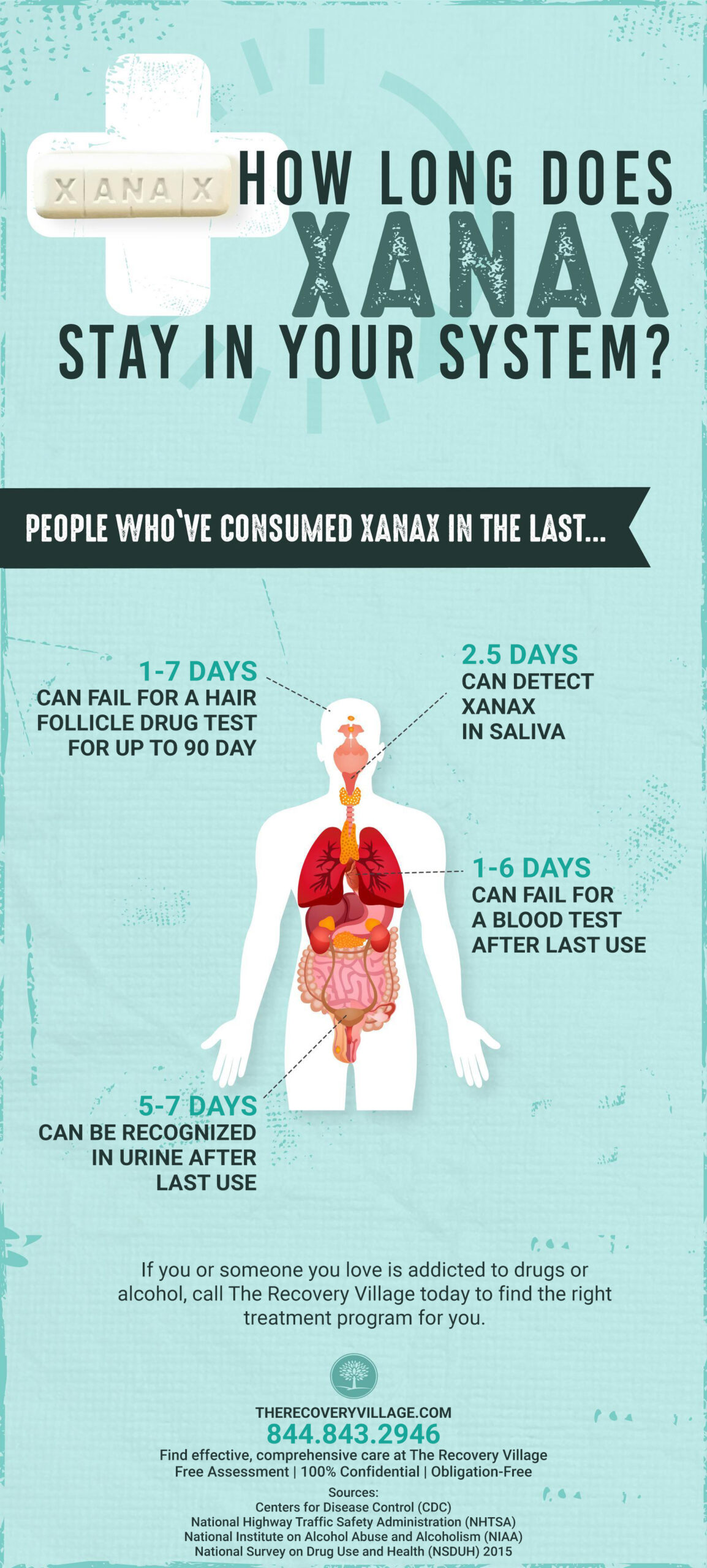Drug tests are commonly used to identify Xanax misuse. Multiple factors affect how long Xanax stays in your system.
Quick Overview
SinceXanax has a half-life of around 12 hours, most users will have the drug out of their systems after 4 days.
- Urine tests can detect Xanax for up to 5-7 days after the last use.
- Saliva tests can detect Xanax for up to 2.5 days after the last use.
- Blood tests can detect Xanax for up to 1-6 days after the last use.
- Hair tests can detect Xanax 1-7 days after last use for up to 90 days.
Xanax has been a life-altering prescription drug for many, freeing them to live a more active life. Current statistics reflect its popularity:from 2005-2013, it was the top prescribed drug in America.However, the more common Xanax use has become, so hasXanax abuse and addiction.
With this in mind, we have provided information about prescribed and non-medical use of Xanax, how long it stays in your body, and what Xanax use disorder looks like so you can recognize the signs for yourself.
What is Xanax and what is it used for?
Xanax is the brand name of alprazolam, a benzodiazepine prescription drug. Benzodiazepines are central nervous system (CNS) depressants, which are used to treat anxiety, insomnia, muscle rigidity, and seizures.Xanax is specifically used totreat Generalized Anxiety Disorder (GAD) and panic disorder.
GAD can be diagnosed when you experience three or more of the following symptoms more often than not for six months or more:
- Continuous, extreme, and unrealistic worry about everyday things
- Anticipating disastrous consequences
- Excessive worry about money, health, family, work, etc.
- Restlessness or edginess
- Uneasiness
- Becoming tired easily
- Having difficulty concentrating
- Irritability
- Tense muscles
- Troubled sleep, including having trouble falling asleep or staying asleep, or experiencing restless sleep
Panic disorder occurs when you experience sudden panic attacks and fear experiencing other panic attacks. Symptoms of panic attacks include:
- Changes in heart rate, including palpitations, pounding heartbeats or accelerated heart rate
- Sweating
- Shaking
- Feeling of shortness-of-breath or choking
- Chest pain
- Nausea or stomach pain
- Feeling dizzy or faint
- Feeling chilled or overheated
- Feelings of unreality (derealization) or being detached from yourself (depersonalization)
- A fear of losing control, losing your mind or dying
Panic disorder can be accompanied by agoraphobia. Agoraphobia is marked by fearing and avoiding places that may inspire panic or might make you feel trapped or helpless. Often you can be afraid of things like public transportation, being in either open or enclosed spaces, or being in a crowd. Usually, a person with agoraphobia will avoid public places or require a friend or family member to accompany them if they venture out. In extreme situations, they may feel unable to leave home.
How long does Xanax last?
Xanax is not considered a long-lasting drug, as the effects last about four hours. Even though the half-life of Xanax is about 11 hours, the medication is no longer effective in the body after four hours. This is why it may have to be taken several times a day, depending on the prescription and severity of symptoms. It’s also why the drug isn’t typically recommended for chronic anxiety.
What are the effects of Xanax?
Xanax, like all benzodiazepines, works by enhancing the activity of gamma-amino butyric acid (GABA) in the brain. GABA, a neurotransmitter, slows the nerve impulses throughout the body, causingsedation and anti-anxiety effects.
Specifically, Xanax is meant to cause calmness and relaxation in order to alleviate the symptoms of GAD, panic disorder, and agoraphobia. It works quickly, often producing the desired effects within minutes, and it begins to alleviate symptoms of GAD and Panic Disorder (with or without agoraphobia) within hours or days of the first dose.
Why do people abuse Xanax?
Xanax can be a target for people with substance use disorders or people looking to get high. It is a high-potency benzodiazepine.
It can induce pleasurable effects such as:
- Lightheadedness
- Relaxation and calmness
- Feelings of unreality
- Having visual, auditory and sensory hallucinations
- Detachment from yourself or your body
- Being talkative
- Deep sleep
- Decreased awareness
- Lack of feeling or emotion
- Increased interest in sex
These side-effects can tempt you to try Xanax for non-medical reasons. The fact that you can feel effects in minutes can be enticing.Xanax also reaches peak blood concentration in 1-2 hours and has a short half-life (as short as 6.3 hours, with an average half-life of 11.2 hours), which allows non-medical users to take it repeatedly and in quick succession.
How do people develop Xanax use disorders?
As with most substance use disorders, people try Xanax originally either out of curiosity or the recommendation of others. Since Xanax is a prescription drug, non-medical users must access someone with a prescription in order to get it.
According to the Centers for Disease Control and Prevention, 55% of non-medical users received prescription pain-killers (including Xanax) for free from a friend or relative, 17.3% abused medications they received from their own doctor, 11.4% bought them from a friend or relative, 4.8% took them from a friend or relative without asking, and only 4.4% bought them from a dealer.
What problems can come from Xanax abuse?
There are many complications that come from abusing Xanax:
Harmful side effects
Side effectsinclude forgetfulness, loss of interest or pleasure, trouble with coordination, trembling, decreased appetite, weight loss or gain, loss of menstruation, double vision, memory problems, lack of inhibition, depression, and lack of emotion.Furthermore, according to Harvard Medical School, using Xanax for 3-6 monthsraised the risk of developing Alzheimer’sby 32%, and taking it for over six months raised the risk by 84%.
Interactions with other drugs or alcohol
Interactionswith other substancescan occur if you have not been properly counseled. Problematic substances include:
- Sedatives and sleeping pills, which can be fatal
- Alcohol, which can lower blood pressure and breathing rate to the point of loss-of-consciousness
- Antihistamines and other allergy medications
Overdose
Overdoseand deathare uncommon but can occur.Benzodiazepines account for 30% of prescription painkiller overdose death and alcohol is a contributing factor in 20% of those deaths. In 2008 alone, prescription painkillers (including benzodiazepines) were involved in 14,800 overdose deaths, more than heroin and cocaine combined.
Xanax Dependence
Dependencecan develop within as short of a time period as two weeks. A more usual time period for dependence is between 1-2 months. Chemical dependence means that your body has gotten used to having a specific amount of the substance in your system. In the case of Xanax, your body will cease to produce GABA on its own, relying solely on Xanax for calm and relaxation.
How and why do people test for Xanax?
People can test for Xanax as part of a compliance program for those with use disorders or history of abuse. If an overdose is suspected, that may be another reason for testing, or as a condition of accepting a job offer.
Urine tests are most frequently used, as they can test for all prescription and illegal drugs. Blood tests can detect everything that urine testing can but are more expensive than urine testing, so they are less common. Hair testing can be used for all illicit drugs and some prescriptions. This type of test is generally used by the justice system to test for chronic drug use.
- In the case of repeated use, urine tests can detect Xanax for up to 5-7 days after the last time it was taken.
- Xanax can be detected in saliva for up to 2.5 days.
- Blood tests can detect Xanax for up to 1-6 days after the last time it was taken.
- Hair tests can detect Xanax starting between 1-7 days after use and can provide a three-month history of drug use.
How long does Xanax stay in your system?
The half-life of Xanaxcan range from 9 to 16 hours, with the average half life at 12 hours. The half life is the amount of time that it takes your body to eliminate half of the drug from your body. Therefore, most users will completely eliminate Xanax from their body within4 days.
There are several factors that can influence how long Xanax stays in your system, such as:
- Your age
- Your height
- Your weight
- Genetics
- Liver function
- Kidney function
- Metabolic rate
- Urinary pH
- The use of other drugs
- Dosage
- Frequency of use
- Amount used
How can you determine if you have a Xanax use disorder?
Signs of a Xanax use disorder include:
- Obsession with the drug
- Fixating on the next dose
- Going through supplies quicker than prescriptions are ready to be refilled
- Taking larger amounts of Xanax than the way in which the prescription was written
- Taking Xanax in a different manner than originally prescribed, such as crushing pills and snorting them
- Experiencing memory loss or mood swings
What sort of treatment is available?
Detoxification from Xanaxshould happen slowly and with inpatient help. Both physical dependency and psychological habit must be addressed in such a program.
Generally, you will be tapered gradually off Xanax and a medication that elicits the same effects will be substituted temporarily, to help withwithdrawal.
Cognitive behavioral therapy can also be used to address the origins of your substance abuse and to develop healthy alternate behaviors and techniques for mastering cravings. If you were initially prescribed Xanax for anxiety, this manner of therapy would also help you find methods to deal with anxiety so as to keep you from experiencing symptoms of your mental illness and helping to prevent relapse.
The best news is that Xanax can be used for legitimate purposes and, when it is abused, there is treatment available so you can live healthily and anxiety-free.

















